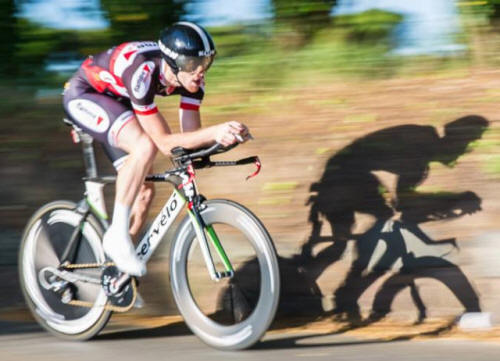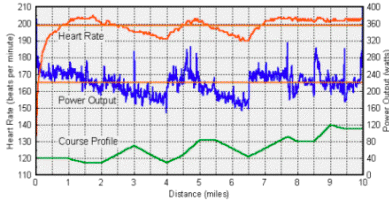Time Trial PB Pacing Strategy

Before we get into the details of time trial strategies, I'll assume that you've prepared well through the winter, eaten the right things in the right amounts, have taken sufficient pre-event rest and have planned a proper warm-up routine.
If you haven't, feel free to check out the other factsheets in this section of the website.
To realise your potential in a time trial, let alone get a personal best or a win, you need to have a plan and a fancy word for a plan is a strategy.
So for the subject of this factsheet, we will discuss just that.
For clients that have done MAP Ramp or wVO2max tests, you'll know exactly what you are capable of. For those that haven't, this could be a step into the unknown. But don't let that put you off; there's still a lot to play for.
A Typical Time Trial
If you want to see how a typical
cyclist approaches a typical time trial all you have to do is stand in
an appropriate place on a typical course.
About two miles in, is the best place, because on an out and back course you get a better perspective of what's happening. At one mile in, the results may be a little skewed, I'll explain why later.

How to do it properly ~ Rich Palmer controlled aggression
Three, two, one,
go!
BANG, 53x14 and a two hundred yard sprint to get up to speed.
Slump back into the saddle, legs filling with lactate, and it's straight
into crisis management as reality and oxygen debt begin to take hold.
Less than a mile in, and you're already thinking "should I change down?"

The above diagram shows how a typical cyclist approaches a typical time trial. The rider being tested was asked to complete a simulated ten mile time trial as fast as they could.
Being a typical cyclist, this was their response. In the first mile, our cyclist got up to a high speed, very quickly. Then, very quickly, began to pay the price. They either overestimated their abilities or underestimated the task; either way the result was the same. A lesson learned.
We can see our test rider averaged 230 watts for the whole ride, effectively this is their 10 mile TT threshold, giving them an FTP of around 218/220 watts. But we don't have their weight, so let's not get too judgemental. Power is a number without context, unless you know the weight that's driving it!
Anyway; their initial burst of enthusiasm resulted in the first mile and a half being ridden at 40 watts above their overall average. This caused the following two and a half miles to be ridden at 50 watts below average!
Hopefully the clever one's out there have already spotted the fundamental flaw, but read on anyway.
So at the four mile point, they were far more under average in both time and watts than they were over it! You can see from the blue line that this pattern was repeated for the rest of the ride.
There is little to suggest that the pattern would not be duplicated, to a greater extent, in a 25 mile time trial.
So the exam question for this section is; "Would their overall average power output, and obviously speed, have been higher if they had not gone over their threshold in the first section of the ride?"
Why not reflect on one of your recent time trials and ask yourself the same question.
A Strategic Time Trial
In a subsequent retest, just a week later,
our rider was coached in the
virtues of using a formulated pacing strategy.

Carsten Koppen ~ on a way to a late summer PB
They were paced using the average power output of their first ride and asked to stay close to this for the first ten minutes. They were then allowed to gently ramp up their performance to levels at which they were comfortably stretched!
We now get to see a completely different outcome.

You don't need a power meter to see this ride was undertaken with far less stress than the first. You can see how heart rate peaked later, a mile and a half in rather than three quarters of a mile.
This obviously created less lactate stress, no strangling oxygen debt, and allowed the rider to develop a smooth powerful rhythm. A rhythm they were able to sustain up to the very end of the ride.
You will also see the average power for the second test was 10 watts higher than the first. This has nothing to do with the rider being fitter or stronger, (how can it be, it was a week later) it was purely down to better management of the psychological and physiological resources they had available. The same resources they had the week before, just used differently.
A measured ride, staying within limits at all times. Actually that last sentence isn't true. With a mile to go you give it everything you've got. Ignore averages, heart rates and aching legs. You should cross the line with nothing in the tank.
The Scores on the Doors
The black line below shows the benchmark of the first ride.
The
red line represents the second test and shows where the rider was, in
time, in relation to the first.
So at a mile in, our rider was four seconds down, at a mile and a half, six seconds down. At three miles they've closed the gap and we now see the effects of our pacing strategy begin to pay off.

In the last seven miles a gap of 85 seconds opens up. That's 12 seconds a mile! How good is that? Bloody good is the answer, and it was all for free!
No sweat, no intervals, no extra training, it's there within all of us. Maybe not to the same extent but I bet we could all go at least 30 seconds quicker if we controlled our emotions and instincts and just applied a little bit of science to our riding.

Florence Cox ~ her legs always go that fast...
The Message
Okay, the above all seems pretty
clear but I'll sum it up in one sentence. Exceeding your average TT power (whatever the distance) then
trying to recover to go again, is not conducive to you producing an optimum
time trial performance.
This really is an undisputable fact not an opinion. If you don't want to experiment in a real live event, come and try a test in the lab.
If someone could guarantee you could go quicker in a ten mile time trial without supplementation, training or spending a fortune on aero stuff wouldn't you take notice?
Why not fight all of your natural instincts to go like a bullet from a gun and give this strategy thingy a go? If you do you will, without doubt, be rewarded.
It would be a shame if a lack of a strategy stopped you making full use of all your hard training and even more frustrating if you didn't realise your true potential on the day. So, good luck in your next time trial, and remember less is more.
Why not give it a go; what's the worst that could happen?
Two Miles In?
Standing one mile in to a time trial course
gives a false impression because on the way out most people are still
hanging on to their initial outbound speed. On the way back they're winding it
up for a big inbound finish, because that's where the crowds are! So you get a skewed impression
of their overall performance.
Standing at one mile most riders appear to be going better than they actually are. At the two mile marker you get a more measured reflection of true performance and suffering!
The Good Old Days
Here's how we did it in the old days. Mavic Cow Horns, head fairing, 24 inch front wheel, Vetta computer, but
still with the Oakley's ~ Factory Pilots, in teal. In fact the same
colour as this page!
Not an SRM, disk wheel, tri-bar or a piece of carbon in site. And we had to take our hands off the bars to change gear, and it had cables not a battery, and we only had seven gears! Enough now...

They talk about being forward on the bike now,
but when your shoulders are ahead of the front wheel skewer
you learn bike handling skills you never knew existed!
Time Trial Programmes
If you are looking to improve hit a PB in your time trials we have a couple of
programmes that can help you.
Follow this link for a reusable, mix and match, eight or twelve
week programme to take you to a PB for ten or twenty-five mile time trials.
Acknowledgement
I would like to thank
ABCC Senior Coach, the late, Malcolm Firth for the use of
his graphics supporting this factsheet.








